Coronation of Edward VII and Alexandra
The coronation of Edward VII and his wife Alexandra as king and queen of the United Kingdom and the British Dominions took place at Westminster Abbey, London, on 9 August 1902. Originally scheduled for 26 June of that year, the ceremony had been postponed at very short notice, because the King had been taken ill with an abdominal abscess that required immediate surgery.[1]
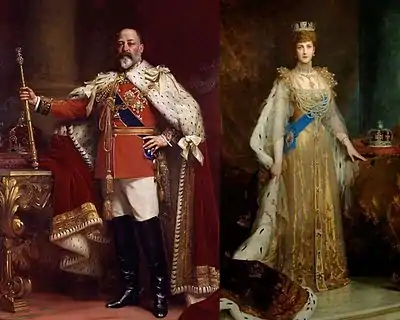 Edward VII and Alexandra in coronation robes, by Luke Fildes | |
| Date | 9 August 1902 |
|---|---|
| Location | Westminster Abbey, London, England |
| Participants |
|
Preparations
The 1838 coronation of Queen Victoria, Edward VII's mother and predecessor, had been an unrehearsed and somewhat lacklustre event in the Abbey, though the newly extended street procession and celebrations around the country had been a great popular success. The success of Victoria's Golden and Diamond Jubilees had created the expectation that Edward's coronation would be an expression of the nation's status as a great imperial power. In December 1901, an Executive Coronation Committee was formed, whose leading member, Viscount Esher, worked closely with the King to set the agenda for the event.[2] Esher had been responsible for organising the Diamond Jubilee in 1897 and was one of the driving forces behind the renewed enthusiasm for royal ceremonial.[3] The position of Director of Music was given to Sir Frederick Bridge, the organist and choirmaster at Westminster Abbey; the first Abbey organist since Henry Purcell to be given that role. Bridge had successfully transformed the quality of music at the Abbey and had directed the music at the Golden Jubilee, for which he had been made a Member of the Royal Victorian Order.[4]
Illness and postponement
By the time of his accession, the 59-year-old Edward was overweight and fond of large meals and cigars. He launched himself into his new role, but his first busy months on the throne were bedevilled by a succession of illnesses and injuries.[5] On 23 June, three days before the date set for the coronation, Edward and his wife, Alexandra of Denmark, returned from Windsor Castle to Buckingham Palace in preparation. Foreign journalists noted that he appeared "worn and pale" and was leaning heavily on his cane. That evening, the King and Queen hosted a formal dinner for seventy British and overseas royal guests.
On the following day at noon, a telegram marked "OFFICIAL" was dispatched around the Empire, with the news that the coronation was postponed and that the King was undergoing an operation. Shortly afterwards, a bulletin was released from Edward's medical team, stating that "The King is suffering from perityphlitis. The condition on Saturday was so satisfactory that it was hoped that with care His Majesty would be able to go through the Coronation ceremonies. On Monday evening a recrudescence became manifest, rendering a surgical operation necessary today".[6] It was undersigned by, among others, Lord Lister and Sir Frederick Treves,[6] who actually carried out the operation on a table in the Music Room at Buckingham Palace, to drain his abdominal cyst.[5]
On 26 June itself, a "solemn service of intercession" was held at St Paul's Cathedral, which was attended by many of the British and foreign dignitaries who were in London for the coronation.[7] Although workmen immediately received instructions to begin dismantling the wooden stands that had been erected along the route of the procession, Edward was insistent that regional celebrations and a planned "Coronation Dinner for the Poor of London" should go ahead.[6] Organised by Sir Thomas Lipton, 500,000 dinners were served to Londoners on 5 July at 800 locations around the capital.[8] The King personally contributed £30,000 towards the cost[9] and there were donations by commercial companies and wealthy individuals. The confectionery maker Rowntree's provided each diner with a tin of chocolate and a rather better one for the 60,000 people who had acted as stewards, on the grounds that they would "be of greater influence socially than the poor".[10]
Many people had intended to watch the coronation procession, and rooms along the planned route had been rented out at high rates for the expected day of the coronation. The postponement of the coronation led to many demands for refunds on the rental contracts, resulting in the "Coronation cases", which set an important precedent in the doctrine of frustration of purpose in the English common law of contract.[11]
The service
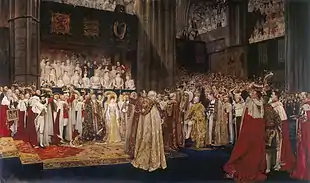
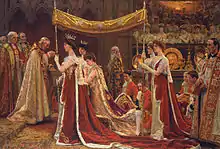
One unintended effect of the postponement was the departure of the foreign delegations; they didn't return for the rescheduled ceremony, leaving their countries to be represented by their ambassadors. This made the coronation "a domestic celebration of the British race united by the influence of the Imperial Crown" according to J. E. C. Bodley, the official historian of the event.[12] Among the 8,000 guests at the Abbey were the prime ministers of the British Dominions, thirty one rulers of the Indian princely states, the Sultan of Perak and the Litunga of Barotseland. The Times enthused that "King Edward is the first of our kings to be attended in his Coronation by an illustrious group of statesmen from our self-governing colonies, as he is the first to be accompanied by a number of the great feudatory Princes of India... They are bound to preserve the fabric of British polity and of British civilisation."[13]
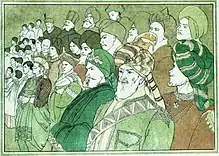
The contents of the service itself had been carefully selected to ensure that its spiritual character was maintained, while keeping the ceremony as brief as possible. The draft was mainly the work of Randall Davidson, the Bishop of Winchester.[14]
The service was conducted by the elderly and infirm Archbishop of Canterbury, Frederick Temple, who would be dead before the end of the year. He steadfastly refused to delegate any part of his duties and had to be supported throughout by two other bishops. Because of his failing eyesight, the text of the service had to be printed in gigantic type onto rolls of paper called "prompt scrolls"; they are preserved in the Lambeth Palace Library.[15] Archbishop Temple provided most of the upsets in an otherwise splendid ceremony; he was unable to rise after kneeling to pay homage and had to be helped up by the King himself and several bishops,[16] he placed the crown back-to-front on the King's head, and when a colleague enquired after his well-being, he was told to "go away!" in a loud voice that was plainly heard by the congregation.[17] The King also deviated from the order of service; when the Prince of Wales touched the Crown and kissed his father's left cheek in the traditional gesture of homage, the King rose to his feet and threw his arms around his son's neck in an unusual display of affection. Another disruption came from the King's sister, Princess Beatrice, who noisily, albeit accidentally, dropped her service book from the royal gallery onto a gold-plate table.[18]
Because he was still convalescing, Edward had been crowned with the Imperial State Crown instead of the intended St Edward's Crown which is heavier. Alexandra was crowned immediately after her husband[19] by William Dalrymple Maclagan, Archbishop of York.[20] She was crowned with a new crown containing the Koh-i-Noor diamond.
Music
On receiving his commission as Director of Music, it was made clear to Frederick Bridge that the coronation needed music of sufficient majesty and grandeur to make the event unparalleled in history. He was assisted by Sir Walter Parratt, the Master of the King's Music, who had the influence at court that Bridge lacked.[21] Bridge decided to make the coronation a celebration of four hundred years of English music.[22] Settings of the coronation texts composed by Thomas Tallis, Orlando Gibbons and Henry Purcell were included alongside works by modern composers such as Arthur Sullivan, Charles Villiers Stanford and John Stainer. New work commissioned for the occasion famously included Hubert Parry's setting of Psalm 122, "I was glad" which skillfully incorporated the traditional acclamation of "Vivat Rex" by the King's Scholars of Westminster School on the entrance of the sovereign. It has been used at every coronation since.[23] French composer Camille Saint-Saëns was also commissioned to write a work for the occasion, his Marche du Couronnement, op. 117. [24]
The music was performed by a choir of 430, a 65-piece orchestra and 10 State Trumpeters. At the 1838 coronation, the organist had attempted to play the instrument and conduct at the same time, with the result that neither function was satisfactory. Bridge not only delegated the organ to Walter Alcock, but also used two sub-conductors, and furthermore alternated with Parratt in conducting from the top of the organ screen. The only real musical error was that Bridge misjudged the timing of I Was Glad and had finished the anthem before the King had arrived, having to repeat it when the right moment came. Bridge was saved by the organist, who improvised in the interim.[25]
Procession
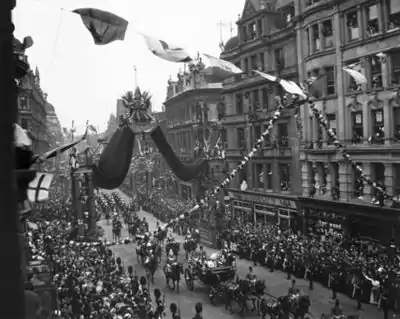
_Benjamin_Stone.jpg.webp)
The Procession in State was originally to have included military contingents from Germany, Austria-Hungary, Denmark, Russia and Portugal.[26] However, following the postponement, these returned home, leaving the parade a wholly British and Imperial affair. Out of a total of 30,000 men marching or lining the route, over 2,000 were representatives of colonial, Dominion or Indian forces. The remainder represented every corps and regiment of the British Army, the Royal Navy and the Royal Marines.[27] A procession of carriages carried British and overseas dignitaries and was followed by the King's equerries, aides-de-camp and eminent commanders including Lord Kitchener, Lord Roberts and Lord Wolseley.[28]
A second procession, which had been planned for the day after the coronation service to tour the City of London and Southwark, was postponed until 25 October because of the King's health.[29]
Coronation Review of the Fleet
_at_Coronation_Fleet_Review_16_August_1902.jpg.webp)
Aside from the postponed procession, the final coronation event was the Review of the Fleet on 16 August at Spithead off the coast at Portsmouth. Without bringing a single warship back from any overseas station, the Royal Navy was able to muster 20 battleships, 24 cruisers and 47 destroyers. A number of foreign warships were invited to participate. An estimated crowd of 100,000 watched from the shore or from pleasure steamers and small boats at sea.[30] Although there had been no less than seventeen fleet reviews during Victoria's reign, this was the first to be associated with a coronation.[31]
On the morning of the review, the King had an audience aboard the royal yacht with three Boer commanders; Louis Botha, Christiaan de Wet and Koos de la Rey. This is remarkable because the Treaty of Vereeniging ending the bitterly fought Second Boer War had only been concluded on 31 May that year. On the following day, the King was well enough to watch fleet exercises at sea.[32]
Royal guests
British royal family
- The Prince and Princess of Wales, the King and Queen's son and daughter-in-law
- Prince Edward of Wales, the King and Queen's grandson
- Prince Albert of Wales, the King and Queen's grandson
- The Princess Louise, Duchess of Fife and The Duke of Fife, the King and Queen's daughter and son-in-law
- Lady Alexandra Duff, the King and Queen's granddaughter
- The Princess Victoria, the King and Queen's daughter
- Princess and Prince Charles of Denmark, the King and Queen's daughter and son-in-law
- Princess and Prince Christian of Schleswig-Holstein, the King's sister and brother-in-law
- Prince Albert of Schleswig-Holstein, the King's nephew
- Princess Helena Victoria of Schleswig-Holstein, the king's niece
- Princess Marie Louise of Schleswig-Holstein, the king's niece
- The Princess Louise, Duchess of Argyll and The Duke of Argyll, the King's sister and brother-in-law
- The Duke and Duchess of Connaught and Strathearn, the King's brother and sister-in-law
- Princess Margaret of Connaught, the King's niece
- Prince Arthur of Connaught, the king's nephew
- Princess Patricia of Connaught, the king's niece
- The Duchess of Albany, the King's sister-in-law
- Princess Alice of Albany, the King's niece
- Princess Henry of Battenberg, the King's sister
- Prince Alexander of Battenberg, the King's nephew
- Princess Victoria Eugenie of Battenberg, the King's niece
- Prince Leopold of Battenberg, the King's nephew
- Prince Maurice of Battenberg, the King's nephew
- The Crown Princess and Crown Prince of Romania, the King's niece and nephew-in-law (representing the King of Romania)
- Princess Louis of Battenberg, the King's niece
- Princess Alice of Battenberg, the King's great-niece
- Princess Frederica of Hanover, the King's second cousin
- The Duke of Cambridge, the King's first cousin once removed
- Adolphus FitzGeorge, the King's second cousin
- Augustus FitzGeorge, the King's second cousin
- The Grand Duchess of Mecklenburg-Strelitz, the King's first cousin once removed (representing the Grand Duke of Mecklenburg-Strelitz)
- The Hereditary Grand Duke of Mecklenburg-Strelitz, the King's second cousin
- Count Edward Gleichen, the King's half-first cousin once removed
- The Earl of Munster, the King's second cousin once removed
Foreign royals
- Kshatriya-Kulaawatans Sinhasanaadheeshwar, Shreemant Rajarshi Sir Shahu Chhatrapati Maharaj Sahib Bahadur
- The Grand Duke of Hesse and by Rhine, the King's nephew
- Prince and Princess Henry of Prussia, the King's nephew and niece (representing the German Emperor)
- The Crown Prince of Denmark, the Queen's brother (representing the King of Denmark)
- The Duke and Duchess of Sparta, the Queen's nephew and the King's niece (representing the King of the Hellenes)
- Prince George of Greece and Denmark, the Queen's nephew
- Prince Andrew of Greece and Denmark, the Queen's nephew
- Ganga Singh, Maharaja of Bikaner
- Nripendra Narayan, Maharaja of Cooch Behar
- Pratap Singh, Maharaja of Idar
- Madho Rao Scindia, Maharaja of Gwalior[33]
- Prince Vajiravudh, The Crown Prince of Siam (representing the King of Siam)
- Lubosi I, King of Barotseland
See also
References
- Arnold Powell (15 March 2010). A Touch of Chutzpah. AuthorHouse. p. 112. ISBN 978-1-4670-0587-6.
- Cowgill, Rachel and Rushton, Julian (2006) Europe, Empire, and Spectacle in Nineteenth-century British Music, Ashgate Publishing Limited, ISBN 978-0-7546-5208-3 (pp. 115–116)
- Range, Matthias (2012), Music and Ceremonial at British Coronations: From James I to Elizabeth II, Cambridge University Press, ISBN 978-1-107-02344-4 (pp. 225–262)
- Beeson, Trevor (2009) In Tuneful Accord: The Church Musicians, SCM Press, ISBN 978-0-334-04193-1 (p. 80)
- Ridley, Jane (2012) Bertie: A Life of Edward VII, Chatto & Windus, ISBN 978-0-7011-7614-3 (pp. 366–367)
- "The Postponed Coronation and Appendix Operation of King Edward VII – 24 June 1902". blog.britishnewspaperarchive.co.uk. The British Newspaper Archive. 23 June 2013. Archived from the original on 24 December 2013. Retrieved 21 December 2013.
- Hopkins, J Castell (1910), The Life of King Edward VII: With a Sketch of the Career of King George V, Project Gutenberg (pp. 386–387)
- Hopkins (p. 398)
- Hopkins (p. 368)
- Davenport-Hines, Peter (1986), Markets and Bagmen: Studies in the History of Marketing and British Industrial Performance, 1830–1939, Ashgate Publishing Limited, ISBN 978-0-566-05066-4 (p. 33)
- See, e.g., Krell v Henry [1903] 2 KB 740.
- Richards, Jeffrey (2001), Imperialism and Music: Britain, 1876–1953, Manchester University Press, ISBN 0-7190-6143-1 (p. 101)
- Richards (pp. 103–104)
- "Lambeth Palace Library Research Guide: Sources for the Coronation" (PDF). www.lambethpalacelibrary.org. Lambeth Palace Library. Retrieved 20 December 2013. (p. 14)
- Lambeth Palace Library Research Guide (p. 19)
- Hopkins (p. 415)
- Ridley (p. 368)
- Dennison, pp. 233–234
- Hopkins (pp. 413–414)
- Battiscombe, Georgina (1969). Queen Alexandra. London: Constable. p. 249. ISBN 0-09-456560-0.
- Cowgill & Rushton (p. 117)
- Richards (p. 104)
- Beeson (p. 80)
- https://www.westminster-abbey.org/media/5252/edward-vii-coronation-music.pdf
- Cowgill & Rushton (pp. 124–125)
- Hopkins (pp. 373–374)
- Hopkins (p. 406)
- Hopkins (p. 373)
- "Royal Visit to the City and South London." (p. 7), 25 October 1902, The Mercury (Hobart, Tasmania), Trove Digitised Newspapers, National Library of Australia. Accessed 22 December 2013
- Hopkins (p. 418)
- Willmott, Hedley Paul (2010) The Last Century of Sea Power: From Washington to Tokyo, 1922–1945, Indiana University Press, ISBN 978-0-253-35214-9 (p. 24)
- Hopkins (p. 419)
- https://www.thegazette.co.uk/London/issue/27489/supplement/6874. Missing or empty
|title=(help)